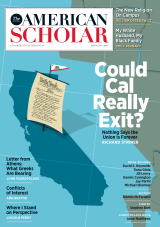 Those who filed North Carolina’s House Bill 147 might find interest in the latest cover story of The American Scholar, the quarterly Phi Beta Kappa publication.
Those who filed North Carolina’s House Bill 147 might find interest in the latest cover story of The American Scholar, the quarterly Phi Beta Kappa publication.
Washington College history professor Richard Striner examines the history of secession, motivated primarily by the discussion of a possible “Calexit” in the wake of Donald Trump’s election.
Early on, Striner reminds us of why secession remains a touchy subject.
The Confederate attempt at secession was grounded in the endeavor to preserve American slavery, a historical truth that cannot be denied by anyone who reads the messages sent to the people of the slave states by members of their secession conventions. The chief intellectual architect of southern secession, the South Carolinian and former vice president John C. Calhoun, often proclaimed that his paramount object in promoting secession was the establishment of a foolproof strategy to thwart the antislavery movement.
Since the foremost attempt to break up the Union was perpetrated by people whose motive cannot survive moral scrutiny, any attempt to revive the principle of secession as an option for the United States today is crippled at the outset by historical associations that are extremely and understandably distasteful. But if we can put aside these associations for a moment, we can first consider the argument for perpetual union and then the evidence that can be used to question it.
The rest of Striner’s article attempts to place the secession of 1861 in context with the rest of American history. He even cites North Carolina in explaining why the prospect of a future secession is not as farfetched as some might think. Striner looks back even further in American history to the time period surrounding the Constitutional Convention.
[I]f the old constitution were to be discarded, and a new constitution could take its place in nine of the 13 states, then it stood to reason not only that the old constitution was being destroyed but also that the perpetual union it created was being destroyed, since nine of the states could continue united—in a union—with the others left out. And that is exactly what happened to the so-called wayward sisters, North Carolina and Rhode Island. After the Constitution had been ratified by nine states in 1788, the controversy continued in other states. By the end of the year, all of them had ratified except those two. The first Electoral College was summoned, and elections were held for the first federal Congress. North Carolina and Rhode Island did not participate in these elections.
North Carolina ratified the Constitution in 1789 and Rhode Island in 1790. Thus the supposedly perpetual union would appear to have been broken for a while by the loss of two states—which then rejoined. And the union they rejoined was not the old one, but a distinctly new one that had replaced it.
In short, the Union has already been successfully broken up, and the Founding Fathers made it happen.
If this reasoning possesses any cogency, one of Lincoln’s points must be reassessed. Lincoln had said that it made no sense to make an existing union “more perfect” by eliminating its perpetuity. This logic is persuasive if “the Union” in question is taken to mean an existing and continuing union. It is not persuasive, however, if one concludes that the original union was destroyed and a brand-new one—a “more perfect Union”—took its place.
Striner goes on to suggest that states’ right of secession remains a subject open to debate.
The political and military outcome of the Civil War settled the issue of southern secession. But the question of whether the Union under the federal Constitution is perpetual or not can never be settled definitively on its merits.
Where does that leave the proponents (and opponents) of secession in 2017 and beyond? If secessionist Californians get a referendum on California nationhood, and if the referendum gives the secessionists the results they are looking for, what happens then? Given the antipathy of a segment of Trump voters to all things Hollywood and by extension all things California, the political calculations in the White House are hard to predict. Other elected leaders and candidates for office, in California and throughout the nation, would certainly ponder the matter. If anyone were to cite Texas v. White, secessionists could counter with a simple question: If the current union, which created the Supreme Court, is now scrapped the way its predecessor union was, how can this court decision be binding? The state attorney general might well be asked to examine legal aspects of that and other questions, including the time-honored right of revolution that Jefferson proclaimed in the Declaration of Independence.
This blog entry is designed neither to endorse “Calexit” nor H.B. 147. It is refreshing to see that California’s fascination with secession has helped separate the issue from its historical baggage.


